|
Tags: cat | National Palace Museum | painting
Whether sketched or realistic in style, or the main character or a supporting cast member, a small animal will always become the focus of attention in a work of art.
The ancient Chinese referred to cats as “li-nu”, which means a wild cat that has been tamed and domesticated. Since antiquity, cats have been employed by people in their familiar roles as pets and mouse catchers, but they sometimes have also served as models for artists, leaping into the world of art for all to see. This is exactly what has happened in this display of famous paintings featuring cats that leave a deep impression on all who view them.
Regardless of the cat's color, any cat that catches a mouse is a good cat.
China throughout much of its history has been an agricultural-based country planting and raising grains and animals. Although the cat does not traditionally figure as one of these animals, The Book of Rites, written at the time of Confucius nearly 3,000 years ago, mentions a sacrificial offering to the cat made by the emperor at the end of every year in gratitude to the cats that protect the fields of grain by catching the hordes of rats and mice. Although the ancient Chinese did not venerate the cat as a deity like the ancient Egyptians, the rat-catching cat protecting grains was the annual recipient of a special ceremony of gratitude and thus enjoyed a status that indeed was a bit higher than other household fowl or domesticated animals.
In previous times, the reason why cats enjoyed their place in society is rooted in the practical value of the special ability in catching mice. It is said that in the first century AD, the emperor Ming (Liu Chuang, r. 58-76) of the Eastern Han dynasty (25-220) was a Buddhist. In order to protect the first Buddhist scripture translated into Chinese, known as Sutra in Forty-two Chapters, from being gnawed by rats, he went to the trouble of having cats specially imported from India to the White Horse Temple, where the texts were stored. Later, in the Sung dynasty (960-1279), such scholar-officials as Huang T'ing-chien (1045-1105) of the Northern Sung and Lu Yu (1125-1210) and Lo Ta-ching of the Southern Sung raised cats to solve their mouse problems and composed poetry in praise of cats. In addition to the materialistic concerns of controlling mice, nimble cats have also been able to melt the hearts of people. With their compulsive cleanliness, cats became one of the most popular pets of women's quarters. Records document that Princess Ch'iung-hua of the Later T'ang (923-935) raised two cats. One was a white cat with a flower-shaped pattern on its face and hence given the name “bridle cicada cat”. The other was a black cat with a white tail that was called “K'un-lun Concubine”. In a chapter in the Ming dynasty (1368-1644) novel The Plum in the Golden Vase, the residence of one of the main female characters, Pan Chin-lian, raised a cat called “Snow Lion” that would fetch her handkerchief and a folding fan, and it would come on command. In the Southern Sung period (1127-1279), Lady Ch'ung-kuo, the granddaughter of the powerful prime minister Ch'in K'uai, ordered a major search for several quadrants of the capital when her favorite cat wandered away.
It is commonly said that “dogs bring wealth” and “cats bring position”. The character for “cat” in Chinese is also a homonym for “octogenarian”, so it is an auspicious metaphor blessing for long life and therefore an appropriate subject in painting. Several painters of cats have been mentioned in art historical texts, including Lu Pien and Tiao Kuang-yin (10th c.) of the T'ang dynasty; Li Ti (12th c.), Ch'i Hsü, Chin Ch'ing, Ho Tsun-shih (9th-10th c.), Wang Ning (11th c.), and Li Ai-chih of the Sung dynasty; Li K'ung-hsiu (1462-1531) and T'ao Ch'eng (15th c.) of the Ming dynasty; and Ah-erh-pai (ca. 17th-18th c.) and Shen Chen-lin (mid-18th to latter half of 19th c.) of the Ch'ing dynasty. Cats have not only been often paired with butterflies and associated with “octogenarian” in the hopes of attaining long life, this display also includes the works 《Noble Peonies in a Vase》by the Ming dynasty emperor-artist Hsüan-tsung (1399-1435) and《Calico Cat under Noble Peonies》by an anonymous Sung dynasty artist. In addition to the homonym with “octogenarian” to offer longevity, these works also include the “king of flowers”--the peony, associated with nobility. There is also《Monkey and Cats》painted by the famous bird-and-flower painter I Yüan-chi (11th c.), in which case the word for “monkey” is a homonym for “becoming a noble”, thereby explaining its appearance with the cats here.
Besides the auspicious connotations, there is always lovable and cute image of cats, with their curious and clever character as well as that unique ability to catch mice and birds and play with insects. Cats are also known for their conflict with other animals, most notably dogs, bringing out the competition in both and resulting in tense interaction between them. These all became favorite subjects of painters. The twenty works that have been selected for display here involve cats as well as their interaction with other animals. In addition to those two unfortunate cats in 《Monkey and Cats》by I Yüan-chi, in which a kitten has been captured by a mischievous macaque, there is also the painting《Hibiscus and Rocks》by Li Ti of the Sung dynasty, in which a cat and dog have come face-to-face in confrontation. There is also the painting of 《Flowers》by Wang Yüan of the Yüan dynasty who depicted a cat having caught a bird and about to have it for lunch. Revealing the mischievous and playful side of cats is an anonymous Sung dynasty work and《Cats at Play》by Shang Hsi (fl. ca. 15th c.) of the Ming dynasty, showing cats frolicking about and playing with insects. These lively and raucous representations of cats are all full of life.
In the ancient Chinese book on cats entitled Classic on Cats is a discussion on the color of the fur of cats. Those of a single color are superior; the foremost being a pure yellow like gold, pure white like silver ranking second, and a pure black like iron being third. However, probably because artists sought variety with their subjects, many of the cats in paintings are calicos of mixed colors. Whether yellow, white, or black, the author of Classic on Cats used the term “appropriate for the four seasons” to describe these cats of the same, pure color from head to tail. As for calico cats, a variety of specialized terms also appears in Classic on Cats. For example, the tricolor black, yellow, and white cat depicted in 《Hibiscus and Rocks》 because the color of the fur has the irregular markings of yellow and black like a tortoise shell, has been called “tortoise shell”. A pure white cat with a black tail, such as that seen lazily lying on a stool in Ch'iu Ying's 《Spring Morning in the Han Palace》of the Ming dynasty, brings to mind a particular image, which is why it is called “spear sticking in snow”. If such a white cat with a black tail has an additional patch on its head, like the one accompanying its master in Chou Wen-chü’s《Lady reading a book》, then the “snow” not only has a streak of black like a spear, it also has a mark that looks like a military seal, which is why it is called “spear with a suspended seal” or a “general cat”. The same pictographic principles also apply to the calico cat with a white stomach and black back in 《Calico Cat and Noble Peonies》, which is known as “dark clouds covering snow”. Likewise, the calico with a yellow back and white stomach in Li Ti's《Portrait of a Cat》 is known as “gold on a bed of silver”. The variety and associations of colors are almost endless.
In fact, among the paintings of cats is an incredible variety depicted by artists through the ages. Of the cats that have been faithfully rendered from life in terms of their external appearance are some extraordinary ones that go beyond mere formal likeness. Among the selections here, one of the more unusual paintings is a leaf from Shen Chou's《Sketches from Life》. At the age of 67, the old scholar-painter Shen Chou (1427-1509) took an extremely original view using a peerless command of black ink for a very humorous rendering, showing this cat curled up like a ball. In fact, this spirited tabby rendered in shades of gray looks just like a bowling ball. In addition, there are cats in works that are not the main character but serve in supporting roles and in the background for the artist. For example, a black-and-white cat with paw extended in 《Children Playing on a Winter Day》by an anonymous Sung artist plays with the brother and sister. Then there is the hungry little calico tempted by the mouth-watering buns in《 Children Cooking Pao-tzu》painted by an anonymous Yüan dynasty painter, adding an extra touch of life to an already festive, auspicious, and lively scene.
Whether sketched or realistic in style, or the main character or a supporting cast member, small animals are almost always one of the main focuses of attention in a work of art. Even bored and restless kids in a museum will stop their complaining as soon as somebody says, “Look at the cat!” It is hoped that the cats in this display of paintings through the ages that now make the National Palace Museum their home will offer everyone who visits these web pages a sense of familiarity. After all, it does not matter whether the cat is a cute little Hello Kitty or a lazy and mischievous Garfield, in the eyes of cat fanciers around the world, representations of cats in ancient or modern as well as Chinese or other art forms reveal both the virtues (and even the drawbacks) of cats that deserve appreciation and understanding. (Wu Sung-fen)
Flowers and Sketches from Life: Wasps and Cat
Tiao Kuang-yin, T'ang dynasty, Album
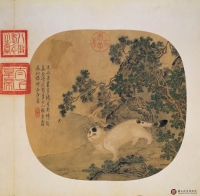 This is the sixth leaf from Tiao Kuang-yin's “Flowers and Sketches from Life”. Leisurely making its way on a forested slope with a rushing stream, a white cat with scattered black spots crouches with eyes alert as it stares at a bee flying in front. This type of pose should be familiar to most people who have raised cats. Tiao Kuang-yin was a famous bird-and-flower painter of the late T'ang dynasty (10 th c.). This album includes the signature for each painter on the leaves calligraphed in gold ink for a very eye-catching effect. The refined brushwork here, although following in the archaic and steady manner of T'ang style painting, is nonetheless probably an imitation done by a later hand.
This is the sixth leaf from Tiao Kuang-yin's “Flowers and Sketches from Life”. Leisurely making its way on a forested slope with a rushing stream, a white cat with scattered black spots crouches with eyes alert as it stares at a bee flying in front. This type of pose should be familiar to most people who have raised cats. Tiao Kuang-yin was a famous bird-and-flower painter of the late T'ang dynasty (10 th c.). This album includes the signature for each painter on the leaves calligraphed in gold ink for a very eye-catching effect. The refined brushwork here, although following in the archaic and steady manner of T'ang style painting, is nonetheless probably an imitation done by a later hand.
Hibiscus and Rocks
Li Ti, Sung dynasty, Album
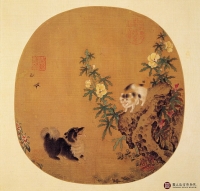 A tricolor calico cat with yellow, black, and white patches as well as a small black dog appear with beautiful butterflies and locked in a stalemate in the corner of a garden among blossoming hibiscus. The startled cat has leapt onto a garden rock and arches its back, staring with fangs bared as if to warn, “Hey, you down there with the big tongue and wagging tail who jumped out at me! Come any closer, and I'll give you a taste of my bite!” How will this tense standoff between the dog and cat end up? The answer lies in the mind of the artist and the imagination of the viewer. In this leaf from the album “Collected Paintings by Sung Artists”, the brushwork is refined and beautifully vivid, infecting the work with an extremely pure and gorgeous quality. In the lower right among the rocks is the signature of the famous Sung dynasty painter Li Ti who was active in the 12 th century, but the brushwork here appears quite late, suggesting an imitation by a later artist.
A tricolor calico cat with yellow, black, and white patches as well as a small black dog appear with beautiful butterflies and locked in a stalemate in the corner of a garden among blossoming hibiscus. The startled cat has leapt onto a garden rock and arches its back, staring with fangs bared as if to warn, “Hey, you down there with the big tongue and wagging tail who jumped out at me! Come any closer, and I'll give you a taste of my bite!” How will this tense standoff between the dog and cat end up? The answer lies in the mind of the artist and the imagination of the viewer. In this leaf from the album “Collected Paintings by Sung Artists”, the brushwork is refined and beautifully vivid, infecting the work with an extremely pure and gorgeous quality. In the lower right among the rocks is the signature of the famous Sung dynasty painter Li Ti who was active in the 12 th century, but the brushwork here appears quite late, suggesting an imitation by a later artist.
Portrait of a Cat
Li Ti, Sung dynasty, Album
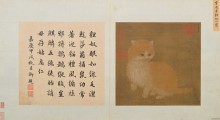 The ancients referred to the cat as a “li-nu”, and scholars were also quite fond of cats, which became one of the subjects favored by artists through the ages. This is the tenth leaf from the album “Famous Paintings of the Sung and Yüan”, in which a yellow and white cat appears to have been startled by something in front of it. Staring with its paw raised, it seems to have been taken aback in this very nimble and cute pose. The artist took painstaking effort to render each and every hair of the cat's fur, using rougher brushwork for the patch of white on the cat's chest to suggest the three-dimensional effect of the longer hair growing there. In fact, great precision was taken in rendering the cat with brushstrokes and ink washes. In the upper right is the artist's signature that reads, “Brushed by Li Ti in the ‘chia-wu' year”. The lower part of the leaf itself bears the trace of a rectangular patch, which is probably where the signature was originally located, but later cut off and remounted in its presented location.
The ancients referred to the cat as a “li-nu”, and scholars were also quite fond of cats, which became one of the subjects favored by artists through the ages. This is the tenth leaf from the album “Famous Paintings of the Sung and Yüan”, in which a yellow and white cat appears to have been startled by something in front of it. Staring with its paw raised, it seems to have been taken aback in this very nimble and cute pose. The artist took painstaking effort to render each and every hair of the cat's fur, using rougher brushwork for the patch of white on the cat's chest to suggest the three-dimensional effect of the longer hair growing there. In fact, great precision was taken in rendering the cat with brushstrokes and ink washes. In the upper right is the artist's signature that reads, “Brushed by Li Ti in the ‘chia-wu' year”. The lower part of the leaf itself bears the trace of a rectangular patch, which is probably where the signature was originally located, but later cut off and remounted in its presented location.
Kitten
anonymous, Sung dynasty, Album
 A white cat with patches of gray and brown looks back. The artist used washes of light gray to render parts of the cat's head, ears, face, back, tail, and hind legs. Specks of white are scattered across the face and limbs, and dark ink was employed to render the patterns on the body. The pupils of the cat's eyes were done with three shades of ink (light, medium, and dark) to suggest the shifting reflections and sparkle. The realistic rendering with fine brushwork makes the distinctions in the fur very clear, and the paw on the ground shaped like a plum blossom also looks very soft and cute. It is said that Princess Ch'iung-hua of the Later T'ang also had such a cat with dappled coloring in its mouth area, making it look like a piebald steed with a bit in its mouth, which is why she named it “bridle cicada cat”. For this reason, later poets often alluded to cats as “bridle cicadas”.
A white cat with patches of gray and brown looks back. The artist used washes of light gray to render parts of the cat's head, ears, face, back, tail, and hind legs. Specks of white are scattered across the face and limbs, and dark ink was employed to render the patterns on the body. The pupils of the cat's eyes were done with three shades of ink (light, medium, and dark) to suggest the shifting reflections and sparkle. The realistic rendering with fine brushwork makes the distinctions in the fur very clear, and the paw on the ground shaped like a plum blossom also looks very soft and cute. It is said that Princess Ch'iung-hua of the Later T'ang also had such a cat with dappled coloring in its mouth area, making it look like a piebald steed with a bit in its mouth, which is why she named it “bridle cicada cat”. For this reason, later poets often alluded to cats as “bridle cicadas”.
Calico Cat and Noble Peonies
anonymous, Sung dynasty, Hanging scroll
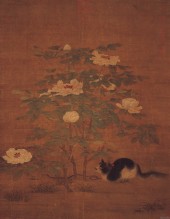 A black-and-white cat crouches below peony blossoms, a red ribbon tied at the back of its neck craning upwards. Along with the beautiful coat of long hair nicely arranged, it suggests that this cat was groomed by somebody and well taken care of. The cat's only problem is that it is tied up, somewhat restricting its freedom to move around. Judging from the thick and steady coloring as well as the varied details and realistic techniques of rendering the three-dimensional effects, this is probably a masterpiece of court painting from the 12 th century in the late Northern Sung period.
A black-and-white cat crouches below peony blossoms, a red ribbon tied at the back of its neck craning upwards. Along with the beautiful coat of long hair nicely arranged, it suggests that this cat was groomed by somebody and well taken care of. The cat's only problem is that it is tied up, somewhat restricting its freedom to move around. Judging from the thick and steady coloring as well as the varied details and realistic techniques of rendering the three-dimensional effects, this is probably a masterpiece of court painting from the 12 th century in the late Northern Sung period.
Monkey and Cats
I Yüan-chi, Sung dynasty, Handscroll
 This work was done by the Northern Sung artist specializing in painting monkeys, I Yüan-chi, who has fully expressed the interactive spirit between the animals portrayed here. A mischievous macaque has suddenly grabbed a kitten passing by. The other kitten escaped its clutches and is frightened, looking back in anger at the macaque as if to think of some way to rescue its playmate. The macaque, however, appears to take no heed of the kitten in its clutches or the response of the kitten by its side, having a devil-may-care and nonchalant attitude towards all the fuss, as if secretly enjoying all the commotion created by its prank on the kittens. After the hairs of the animals' fur were painted in one by one, washes of color were added to create a layered and fluffy appearance. The red ribbons worn by these two kittens are similar to those in “Calico Cat and Noble Peonies” and “Children Playing on a Winter Day”, indicating that this was perhaps a custom among the wealthy in the Sung dynasty when raising pets.
This work was done by the Northern Sung artist specializing in painting monkeys, I Yüan-chi, who has fully expressed the interactive spirit between the animals portrayed here. A mischievous macaque has suddenly grabbed a kitten passing by. The other kitten escaped its clutches and is frightened, looking back in anger at the macaque as if to think of some way to rescue its playmate. The macaque, however, appears to take no heed of the kitten in its clutches or the response of the kitten by its side, having a devil-may-care and nonchalant attitude towards all the fuss, as if secretly enjoying all the commotion created by its prank on the kittens. After the hairs of the animals' fur were painted in one by one, washes of color were added to create a layered and fluffy appearance. The red ribbons worn by these two kittens are similar to those in “Calico Cat and Noble Peonies” and “Children Playing on a Winter Day”, indicating that this was perhaps a custom among the wealthy in the Sung dynasty when raising pets.
Children Playing on a Winter Day
anonymous, Sung dynasty, Hanging scroll
 In this ancient painting appear plum blossoms and camellia interspersed with orchids and bamboo. Two young children, apparently a sister with her young brother, are playing under the blossoms. The girl is holding a small colorful pennant, and her young brother grasps a red string to which is tied a peacock feather as they tease the small kitten nearby. Although the kitten is separated from the children by some distance, its eyes are nevertheless fixed on the toys held by the brother and sister as it raises a paw about to follow in hot pursuit. Maybe because the boy is a little frightened by the sudden movement of the cat, he seems to be hiding behind his sister, anticipating the cat's attack. The brushwork of this painting is very similar to another painting in the National Palace Museum collection entitled “Children Playing on an Autumn Day” by Su Han-ch'en of the Sung dynasty. Various elements, including the texturing of the rocks, rendering of the children's faces, and tracing of the drapery lines, are all very much alike--even the dimensions of the two works are similar. Thus, these two were perhaps painted by the same artist and may have been part of a set of paintings of children playing in the four seasons, this one representing winter.
In this ancient painting appear plum blossoms and camellia interspersed with orchids and bamboo. Two young children, apparently a sister with her young brother, are playing under the blossoms. The girl is holding a small colorful pennant, and her young brother grasps a red string to which is tied a peacock feather as they tease the small kitten nearby. Although the kitten is separated from the children by some distance, its eyes are nevertheless fixed on the toys held by the brother and sister as it raises a paw about to follow in hot pursuit. Maybe because the boy is a little frightened by the sudden movement of the cat, he seems to be hiding behind his sister, anticipating the cat's attack. The brushwork of this painting is very similar to another painting in the National Palace Museum collection entitled “Children Playing on an Autumn Day” by Su Han-ch'en of the Sung dynasty. Various elements, including the texturing of the rocks, rendering of the children's faces, and tracing of the drapery lines, are all very much alike--even the dimensions of the two works are similar. Thus, these two were perhaps painted by the same artist and may have been part of a set of paintings of children playing in the four seasons, this one representing winter.
Children Cooking Pao-tzu
anonymous, Yüan dynasty, Hanging scroll
 A screen has been erected in front of a hall as three children gather around hot charcoals where they heat buns together and get ready to eat them as one of them still plays by the side. The hats these children are wearing as well as the thick clothing indicate this is most likely a winter day. Steam rises from the buns heated above the hot coals, symbolizing the “Buns All Together”--suggesting the warmth of a family reunion, hence an auspicious theme. The scent of the buns has also attracted a cat, which looks up at the buns with a face as if asking one of the boys to give it a taste.
A screen has been erected in front of a hall as three children gather around hot charcoals where they heat buns together and get ready to eat them as one of them still plays by the side. The hats these children are wearing as well as the thick clothing indicate this is most likely a winter day. Steam rises from the buns heated above the hot coals, symbolizing the “Buns All Together”--suggesting the warmth of a family reunion, hence an auspicious theme. The scent of the buns has also attracted a cat, which looks up at the buns with a face as if asking one of the boys to give it a taste.
Kittens Playing Beneath Flowers
Emperor Hsüan-tung, Ming dynasty, Hanging scroll
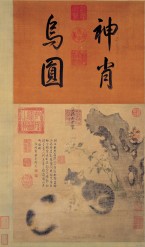 Chu Chan-chi (1399-1435), the fifth emperor of the Ming dynasty known as Hsüan-tsung, was also very gifted at painting and calligraphy. This work depicts two cats cleaning themselves among a garden rock and wild chrysanthemums. The artist first filled in the base color with washes and then outlined and washed the spots and painted in the cats' fur. The Lake T'ai garden rock was first outlined with ink and then provided with texturing using a brush with dry ink, while the chrysanthemums were rendered with fine brushwork for delineation and then filled with colors. This painting of cats is done in imitation of the style of the Hsüan-ho Imperial Painting Academy artist Li Ti in the Sung dynasty, bearing much of his pure and elegant manner.
Chu Chan-chi (1399-1435), the fifth emperor of the Ming dynasty known as Hsüan-tsung, was also very gifted at painting and calligraphy. This work depicts two cats cleaning themselves among a garden rock and wild chrysanthemums. The artist first filled in the base color with washes and then outlined and washed the spots and painted in the cats' fur. The Lake T'ai garden rock was first outlined with ink and then provided with texturing using a brush with dry ink, while the chrysanthemums were rendered with fine brushwork for delineation and then filled with colors. This painting of cats is done in imitation of the style of the Hsüan-ho Imperial Painting Academy artist Li Ti in the Sung dynasty, bearing much of his pure and elegant manner.
Noble Peonies in a Vase
Emperor Hsüan-tsung, Ming dynasty, Hanging scroll
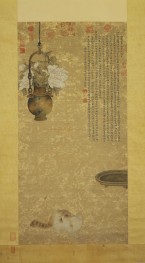 According to the inscription, this work was painted by the Ming emperor Hsüan-tsung as a gift for the high official Yang Shih-ch'i. The cat in the painting curiously looks up at the peonies placed in the suspended bronze vase, as if wanting to jump up and take a closer look. The word for “cat” in Chinese is a homonym for “octogenarian” and has served as an auspicious symbol for long life, while the peony is regarded as the “king of flowers”, suggesting nobility and wealth. Here, the cat was painted with fine brushwork and utmost detail. In the suspended bronze flower vase are three blossoms, in which the layers of green leaves cover the handles of the bronze vase, making for a scene of great grace and beauty.
According to the inscription, this work was painted by the Ming emperor Hsüan-tsung as a gift for the high official Yang Shih-ch'i. The cat in the painting curiously looks up at the peonies placed in the suspended bronze vase, as if wanting to jump up and take a closer look. The word for “cat” in Chinese is a homonym for “octogenarian” and has served as an auspicious symbol for long life, while the peony is regarded as the “king of flowers”, suggesting nobility and wealth. Here, the cat was painted with fine brushwork and utmost detail. In the suspended bronze flower vase are three blossoms, in which the layers of green leaves cover the handles of the bronze vase, making for a scene of great grace and beauty.
Listening to a Zither
anonymous, Yüan dynasty, Hanging scroll
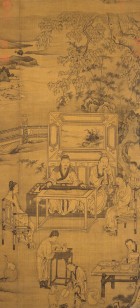 In ancient times, scholars often raised cats to protect their rare books from being gnawed by mice. This work is done in the “pai-miao” manner of ink outlines and shows tall pawlonia and shady bamboo. In the garden is a curving rail by a pond as a scholar sits on a daybed plucking a zither. Three other scholars sit around him and listen intently as four attendants are busy in waiting, adding incense, grinding tea, and heating wine. In a corner of the painting, two cats cannot control their nature as they break out in play around a basket, adding a lively and endearing touch to the otherwise staid and refined atmosphere of scholars. In the Ming and Ch'ing dynasties was a popular trend towards using display items and furniture, and this painting reflects the residential garden of an upper-class family, in which everything is very fastidiously arranged. Judging from the furniture here, this work attributed to the Yüan dynasty was probably actually done in the late Ming dynasty.
In ancient times, scholars often raised cats to protect their rare books from being gnawed by mice. This work is done in the “pai-miao” manner of ink outlines and shows tall pawlonia and shady bamboo. In the garden is a curving rail by a pond as a scholar sits on a daybed plucking a zither. Three other scholars sit around him and listen intently as four attendants are busy in waiting, adding incense, grinding tea, and heating wine. In a corner of the painting, two cats cannot control their nature as they break out in play around a basket, adding a lively and endearing touch to the otherwise staid and refined atmosphere of scholars. In the Ming and Ch'ing dynasties was a popular trend towards using display items and furniture, and this painting reflects the residential garden of an upper-class family, in which everything is very fastidiously arranged. Judging from the furniture here, this work attributed to the Yüan dynasty was probably actually done in the late Ming dynasty.
Cats and Grasses
T'ao Ch'eng, Ming dynasty, Handscroll

In this long handscroll painting, a total of 24 Persian cats of different colors and sizes have been rendered on the grass in various forms of respite and play. Several bigger cats in the painting have kittens snuggling against them, as this lineup perhaps represents the members of several cat families. In the middle section of the handscroll, the large yellow tabby with two kittens includes a scene of several butterflies flying about. Cats and butterflies in Chinese are a homonym for “living to old age”, serving as an auspicious blessing for longevity.
Sketches from Life: Cat
Shen Chou, Ming dynasty, Album
 Shen Chou (1427-1509) was a native of Soochow in Kiangsu and went by the style name Ch'i-nan and the sobriquets Shih-t'ien and Pai-shih-weng. Gifted at poetry and calligraphy, he excelled at landscape painting and also depicted plants and animals in monochrome ink. This painting of a cat is one of sixteen leaves in an album of plants and animals sketched from life that Shen Chou did at the age of 67. Perhaps the day the artist painted was cold, because the cat shown here is rolled into a ball as if to keep warm. The two gleaming eyes stand out against the gray fur and seem to stare in alertness as if scanning the upper right for anything going on. The cat has a supple body and can position itself into most any “yoga” pose. The composition of this original portrayal seems to have been based on this “acrobatic” skill of the cat.
Shen Chou (1427-1509) was a native of Soochow in Kiangsu and went by the style name Ch'i-nan and the sobriquets Shih-t'ien and Pai-shih-weng. Gifted at poetry and calligraphy, he excelled at landscape painting and also depicted plants and animals in monochrome ink. This painting of a cat is one of sixteen leaves in an album of plants and animals sketched from life that Shen Chou did at the age of 67. Perhaps the day the artist painted was cold, because the cat shown here is rolled into a ball as if to keep warm. The two gleaming eyes stand out against the gray fur and seem to stare in alertness as if scanning the upper right for anything going on. The cat has a supple body and can position itself into most any “yoga” pose. The composition of this original portrayal seems to have been based on this “acrobatic” skill of the cat.
Cats Playing
anonymous, Sung dynasty, Hanging Scroll
 This painting is attributed to a Sung dynasty artist and depicts a total of eight cats of varying sizes playing in the corner of a garden. The railing encircles the scenery and provides a backdrop to link the subjects together, making the garden appear like an enclosed space. The cats play among garden rocks, clusters of bamboo, peach trees, and peonies. Whether still or moving about, they appear vivid and lively. The painter with close observation has taken a “cat's-eye” view of the world to represent this scene of cats at play, which probably took place in strong sunlight judging from the slits of the cats' eyes.
This painting is attributed to a Sung dynasty artist and depicts a total of eight cats of varying sizes playing in the corner of a garden. The railing encircles the scenery and provides a backdrop to link the subjects together, making the garden appear like an enclosed space. The cats play among garden rocks, clusters of bamboo, peach trees, and peonies. Whether still or moving about, they appear vivid and lively. The painter with close observation has taken a “cat's-eye” view of the world to represent this scene of cats at play, which probably took place in strong sunlight judging from the slits of the cats' eyes.
Cats Among Bamboo
Shen Chen-lin, Ch'ing dynasty, Hanging Scroll
 Shen Chen-lin, a Ch'ing dynasty court painter who specialized in figures and landscapes, once received a plaque from the Dowager Empress Tz'u-hsi that read, “From the marvelous hand of the imperial brush transmitting the spirit”. In this painting are three Siamese cats. The larger one is crouched on top of a garden rock next to bamboo looking down at two smaller cats (one white and the other yellow) playing on the grass below. The white cat looks like it is about to deal with the yellow cat nearby. All three cats wear tassels of red and golden bells for collars in a realistic description that seems to have been painted directly from life.
Shen Chen-lin, a Ch'ing dynasty court painter who specialized in figures and landscapes, once received a plaque from the Dowager Empress Tz'u-hsi that read, “From the marvelous hand of the imperial brush transmitting the spirit”. In this painting are three Siamese cats. The larger one is crouched on top of a garden rock next to bamboo looking down at two smaller cats (one white and the other yellow) playing on the grass below. The white cat looks like it is about to deal with the yellow cat nearby. All three cats wear tassels of red and golden bells for collars in a realistic description that seems to have been painted directly from life.
Cats at Play
Shang Hsi, Ming dynasty, Hanging Scroll
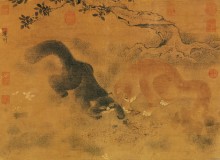 In the shade of a tree, a group of ants are on the move but have the misfortune of encountering a pair of naughty cats. They paw excitedly at the various belongings of the ants being moved, including a cricket, butterfly, mole cricket, and wasp. In the process, the cats seem to be making a mess of the orderly troop of ants. Looking at this yellow cat and its black partner engrossed at play without a care in the world perfectly captures the mischievous feline character.
In the shade of a tree, a group of ants are on the move but have the misfortune of encountering a pair of naughty cats. They paw excitedly at the various belongings of the ants being moved, including a cricket, butterfly, mole cricket, and wasp. In the process, the cats seem to be making a mess of the orderly troop of ants. Looking at this yellow cat and its black partner engrossed at play without a care in the world perfectly captures the mischievous feline character.
Flowers
Wang Yüan, Yüan dynasty, Handscroll

Cats, both domesticated and wild, have always been hunters of utmost skill. This handscroll shows a cat with a bird in its mouth that it has just caught. The cat at the end of the scroll seems to have just finished a satisfying meal of fowl, having fallen fast asleep in front of a pile of bird feathers. In the middle of the scroll are three cats. The white cat with a black tail is in front, looking up as if about to jump. In the middle lies another on the ground, using its paw to pull and play at a branch drooping down. The tabby is licking its paws and grooming itself, revealing the cat's habit of cleanliness. This handscroll simultaneously portrays the wild, adroit, naughty, clean, and lazy side of cats all in one painting.
Lady Reading a Book
Chou Wen-chü, Five Dynasties Period (Southern T'ang), Hanging Scroll
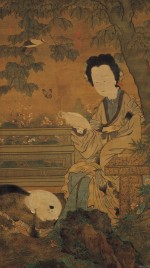 This cat accompanying its lady master reading in the shade of a pawlonia tree seems to have the mane and long hair of a male lion. This is perhaps the breed said to have come from the West and known in ancient times as “lion cat”. The artist has rendered the hair with detailed brushstrokes, showing the orderly hair as parted down the middle. White pigment has also been added to the back and hind legs to create a more realistic three-dimensional effect. Its yellow eyes have been done with washes of light to dark color to successfully render the reflective and three-dimensional quality of this part of the cat. The pupils of the eyes are reduced to slits to reveal its sidelong glance. In China , this type of white cat with a black or yellow tail and a patch of the same color on its head is known as “seal and spear” and “whipped ball of silk”. The figures painted by Chou Wen-chü (10 th c.) were done with fine and jagged lines that are also full and flowing, the mix of the two creating a trembling energy bearing grace and composure. Chou especially excelled at figure paintings of ladies. This work, however, does not bear the signature of the artist. In fact, the drapery lines and vigorous turns of the strokes appear quite remote from the style of Chou Wen-chü and probably represent the work of a later painter, the collector adding Chou's signature for prestige.
This cat accompanying its lady master reading in the shade of a pawlonia tree seems to have the mane and long hair of a male lion. This is perhaps the breed said to have come from the West and known in ancient times as “lion cat”. The artist has rendered the hair with detailed brushstrokes, showing the orderly hair as parted down the middle. White pigment has also been added to the back and hind legs to create a more realistic three-dimensional effect. Its yellow eyes have been done with washes of light to dark color to successfully render the reflective and three-dimensional quality of this part of the cat. The pupils of the eyes are reduced to slits to reveal its sidelong glance. In China , this type of white cat with a black or yellow tail and a patch of the same color on its head is known as “seal and spear” and “whipped ball of silk”. The figures painted by Chou Wen-chü (10 th c.) were done with fine and jagged lines that are also full and flowing, the mix of the two creating a trembling energy bearing grace and composure. Chou especially excelled at figure paintings of ladies. This work, however, does not bear the signature of the artist. In fact, the drapery lines and vigorous turns of the strokes appear quite remote from the style of Chou Wen-chü and probably represent the work of a later painter, the collector adding Chou's signature for prestige.
Advanced-Scholar Chung K'uei Moving
Kung K'ai, Sung dynasty, Handscroll
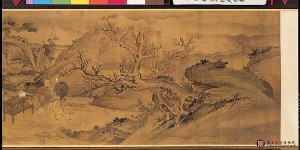 Kung K'ai (1222-1307), a native of Huai-yin in Kiangsu , was particularly fond of painting demons and the demon-queller Chung K'uei in a most unusual manner. Unfortunately, very few of his works survive. Although this work bears an old attribution to Kung K'ai, the style is different from that associated with him and is probably a painting by a Ming dynasty or later painter to which Kung K'ai's name has been attached. This handscroll shows Chung K'uei riding on a spotted deer leading a motley band of demons and spirits pulling a cart with his sister to be married off. The woman's dowry includes many auspicious objects that add to the festive mood of the painting. At the rear of the troupe are two demons holding a table on which is a large white cat with a black nose and tail tied by a string to the handle on top of a drawer. It is shown glaring at the burdened demon behind and probably part of the dowry being moved.
Kung K'ai (1222-1307), a native of Huai-yin in Kiangsu , was particularly fond of painting demons and the demon-queller Chung K'uei in a most unusual manner. Unfortunately, very few of his works survive. Although this work bears an old attribution to Kung K'ai, the style is different from that associated with him and is probably a painting by a Ming dynasty or later painter to which Kung K'ai's name has been attached. This handscroll shows Chung K'uei riding on a spotted deer leading a motley band of demons and spirits pulling a cart with his sister to be married off. The woman's dowry includes many auspicious objects that add to the festive mood of the painting. At the rear of the troupe are two demons holding a table on which is a large white cat with a black nose and tail tied by a string to the handle on top of a drawer. It is shown glaring at the burdened demon behind and probably part of the dowry being moved.
Spring Morning in the Han Palace
Ch'iu Ying, Ming dynasty, Handscroll

The cat, which loves cleanliness and makes little noise, has always been one of the favorite pets of the women's quarters. Many paintings of ladies often include a cat for accompaniment. The title of this handscroll indicates a spring morning one day at the Han dynasty court. It depicts the life in the women's quarters in a wide range of scenery with brushwork fine yet strong and colors opulent yet refined. The scenery is interspersed with trees and rocks, providing natural elements to make this look like a realm of the immortals. The middle of the handscroll depicts a lively scene of palace figures dancing and playing music in front of a hall. The cat usually accompanying its master has some time to itself and is lazily coiled up on a drum-shaped stool in a back room of the palace.
Text and images are provided by National Palace Museum Digital Archives Projects
|






























